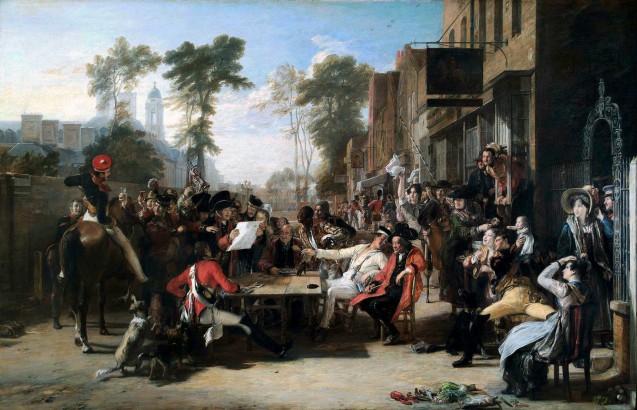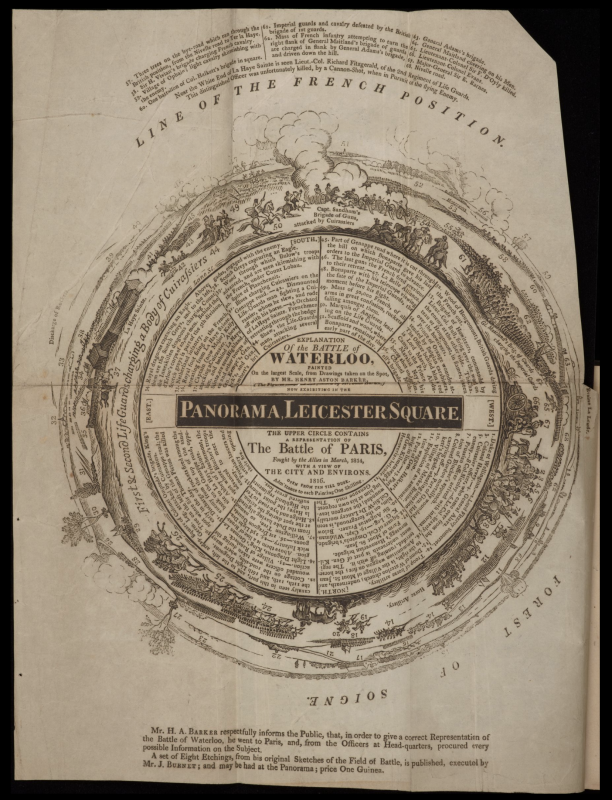Major Percy’s journey
Wellington wrote the dispatch from Waterloo and entrusted its delivery to London (with two French ‘eagles’ captured at the battle) to his ADC Major Henry Percy, son of the Duke of Northumberland, one of the few of the general’s ADCs to survive the day’s carnage unscathed. Indeed, he only realised how close he had come to death when, having done his duty, he collapsed from fatigue onto his bed two days later, and while undressing, a piece of the brains of a man who had been wounded beside him fell from the folds of his clothing… Percy, of the 11th Light Dragoons, made a dramatic ride and an epic Channel crossing – during a lull in the wind, Percy and his companion even had to row – before arriving in London on the night of Wednesday 21 June. Not finding the Minister of War, Bathurst, at home, Percy then went to look for the Prime Minister, Lord Liverpool, who took him to the Prince Regent who was dining in town. The major placed the ‘eagles’ before the Prince, who blessed God, wept for the dead, and promoted Percy. According to a diary entry written at the time: “All London thrown into agitation – people quitting balls and assemblies as the news was conveyed of the wounds or deaths of relatives. Many ladies fainted. There was a rumour, before the news came, of a great battle and retreat, and even defeat. People were much depressed; therefore the reaction was immense.”[1] Others testified to spontaneous singing of “God save the King”, drinking toasts on street corners, and the noise of the watchmen’s rattles and dustmen’s bells.[2]
The absence of a national monument
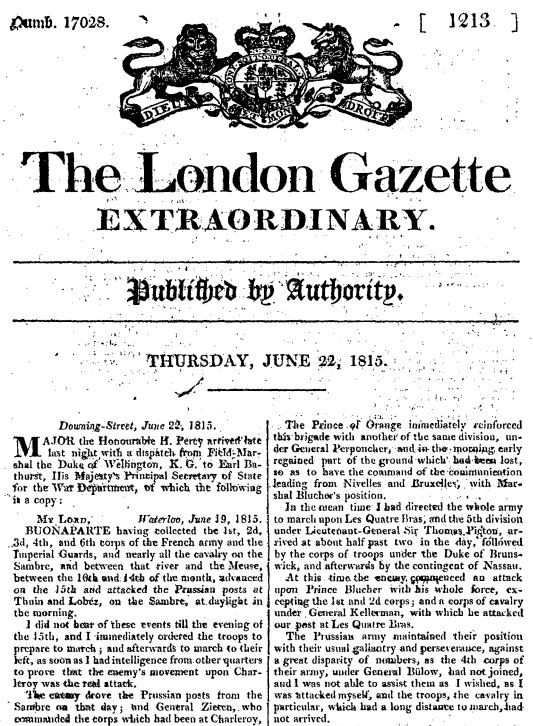
On 29 June, Lord Castlereagh rose in the House of Commons to make a speech about the Battle of Waterloo.[3] The news and the French ‘eagles’ had arrived in the British capital four days after the immense combat: the eagles arrived in the evening of Wednesday 21 June, and the official news was published on Thursday 22 June, in the London Gazette Extraordinary.
Indeed this official newspaper, which was published twice a week (Tuesdays and Saturdays), put out an extraordinary edition on Thursday 22 June, in which it published Wellington’s Waterloo despatch.[4] In addition to the newspaper report, placards were hung at Mansion House. Cannon shots were fired and church bells rung. The Minister of Foreign Affairs noted in the House of Commons that until 25 June, the only official information received was the dispatch from Waterloo delivered by Wellington’s aide-de-camp, Major Percy. It was necessary, he said, to wait for the news from France to understand the true extent of this victory and the catastrophic consequences for France.
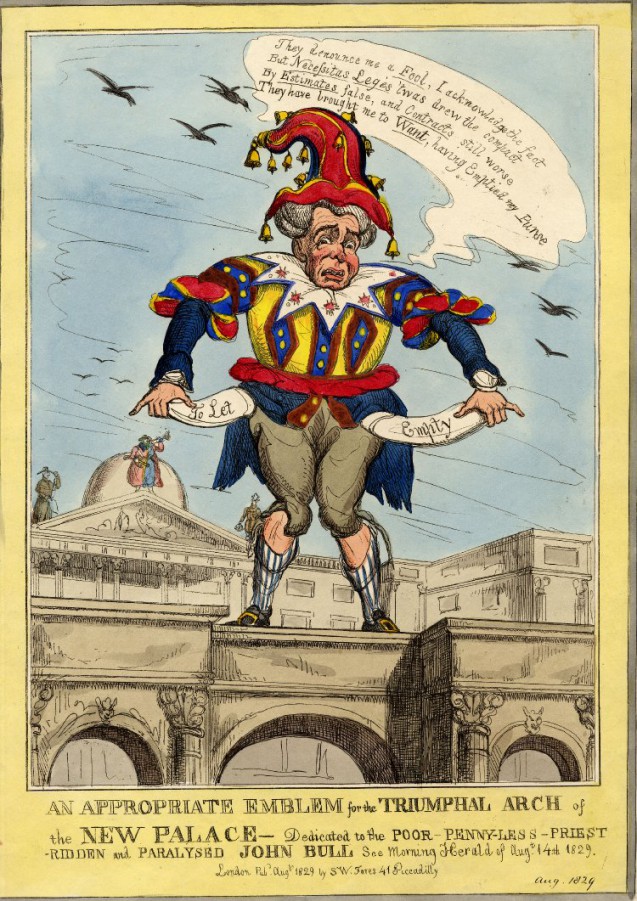
Given the exceptional scale of the victory, noted Castlereagh, the British government had to do something more than its usual way of celebrating ‘ordinary’ triumphs. Already, there was talk of a national monument, and not only officers were to be commemorated, but also rank and file. Among others, Thomas Picton and Sir William Ponsonby (whose deaths had been highlighted in the newspapers carrying the earliest news) were chosen for a very special commemoration. Among other speakers in the debate following Castlereagh’s speech, Charles Williams-Wynn – a more or less centrist politician – asked to be assured that the monument would not be erected in a church – which was granted. There was also talk of building a palace for Wellington at the expense of the realm; Castlereagh finally opted for an arch – the famous “Marble Arch” -, a stylistic mix of ancient Roman arches with Napoleon’s Arc de Triomphe du Carrousel (1808) located in front of the Tuileries Palace. In the end, no doubt surprisingly – and notwithstanding the good patriotic sentiments of the Members of Parliament – no national monuments or palaces were built. The Marble Arch was not a national monument but was intended as a specific monument to the Prince Regent, and although it was decorated with motifs from the battle of Waterloo, it was dedicated more to the (personal) victory of the Prince Regent over Napoleon. It was therefore planned as the main entrance to Buckingham Palace (the royal palace which was empty at the time and still under construction), a position that mirrored that of the arch in front of the Tuileries Palace. The arch did not become a national monument until 1851 when it was moved to the corner of Hyde Park.[5] Indeed, in the years following Waterloo (until 1825) the British government was more concerned with the discontent of the people, and with the economic interests of the emergent empire that occupied the minds of the politicians more and more. Only Nash’s extensive urban planning ventures for the British capital succeeded, namely Trafalgar Square (with its privately funded monument to Nelson), Regent Street and Waterloo Square.
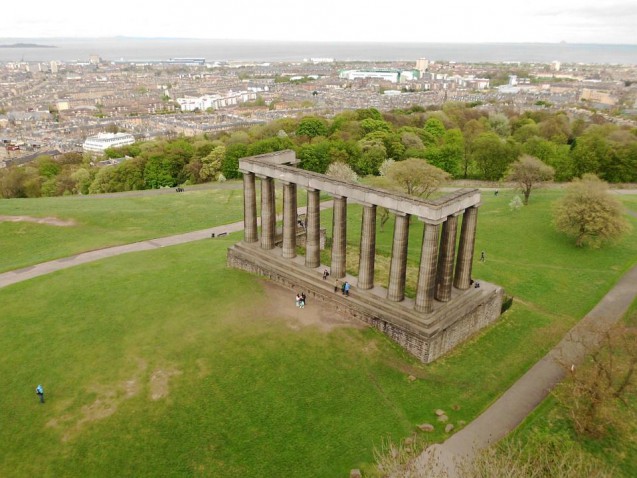
Outside London, the only large-scale monument of national significance in the British Isles was William Playfair’s Pantheon or “National Monument”, erected on Carlton Hill, Edinburgh, construction of which began in 1826 but which was never completed apart from a few columns and architraves, and which today is still an embarrassing folly.[6]
A medal “of discord”
Another Williams-Wynn project was more successful. He had asked for a commemorative medal to be designed, like the one for the Battle of the Nile in 1798, but he wanted it to be a state medal and not a private one like the first one made for Nelson.[7] But even a unifying project like this one was not free from uncertainty as to how best to celebrate this resounding victory on a national scale. On Wellington’s request, the Prince Regent commissioned the medal on 10 March 1816, and he intended it for all who had been present at Waterloo on 16 and 18 June 1815.
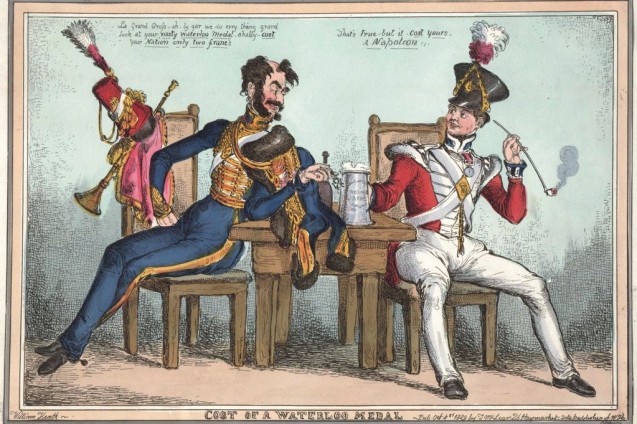
Unfortunately, the distribution caused nothing but disagreement. The veterans of the Peninsular War (which had lasted from 1808 to 1814) were outraged that masses of recruits who had served only a few months should receive a medal, whereas they themselves had never received any other honours than votes of thanks in Parliament. It was only in… 1848 – 30 years after the end of the hostilities of what was then called the Great War, and with a third of the former combatants already dead – that the veterans of the Iberian campaigns got their own medal, finally putting an end to the dispute between the two groups of veterans. From then on, the two medals were worn together. Nevertheless, the whole affair left a bitter aftertaste. Did the Marquess of Londonderry not tell the House in 1848 that the medal seemed to have been awarded reluctantly?
Liberals and conservatives: two reactions
The announcement of a French victory at Waterloo, made on 22 June 1815 by Lord Grey and Robert Wilson (cited at the beginning of this article) and their embarrassment at the contradictory news are typical of British Liberal reactions.[8] For example, seven years after the epic clash near Brussels, the poet Lord Byron, beloved of the Liberals, who was thoroughly depressed by the outcome of the battle, made a head-on attack on what he called the cynicism and selfishness of the victors at Waterloo in his poem, The Age of Bronze.[9] For him 1815 was an annus haud mirabilis (by no means a wonderful year). Already the day after the battle, he had written the third canto of his Childe Harold’s Pilgrimage (1816), which also criticized the victory, since it put a king back on the French throne.[10] For him, the victory at Waterloo benefited only those who became rich at the expense of the poor, particularly as a result of the price of wheat and the shortage of work in the factories that had been running at a slower pace since the end of the war. It is well known that the Whig politician Samuel Whitbread committed suicide on 6 July by cutting his throat with a razor. A great admirer of Napoleon, this Whig Member of Parliament, who had sung the Emperor’s praises in the House throughout the war, was depressed by the result at Waterloo.[11] And the day after the battle, the literary critic William Hazlitt, author of a biography of Napoleon and a devoted historian of Napoleon and the French Revolution, fell into a depression that lasted for weeks, as he considered it a battle with fatal consequences.[12] There were also other illustrations of political delusion.[13] Temples of non-conformist Protestants refused to participate in the national day of general thanksgiving decreed for 7 July 1815. A Unitarian Minister from Manchester, Robert Apsland, noted that day: “This is the thanksgiving day (for the defeat of Bounaparte), but I feel no gratitude for it, and can express none, for the shedding of blood, and the creating of widows and orphans.”[14] Apsland also deplored the return of Catholicism to France (and the repression of the Protestants) and the reintroduction of slavery. At the same time, those on the right in Great Britain felt justified in their opposition to Napoleon. Most of the many accounts that followed the battle expressed loyalty.[15] An interesting exception is Willem Lodewyck Van-Ess’s astonishing description of the battle in the second part of the eighth volume of his Life of Napoleon Buonaparte, published in 1823, which tells of Napoleon’s half-victory, at least up until 7 pm on 18 June.[16] The great national poets, Wordsworth, Southey and Walter Scott, composed and published triumphant verses in 1816.[17] For them, the victory at Waterloo was proof of British, political, military and human superiority. William Mudford’s very long account of the battle, accompanied by many sumptuous colour illustrations, is typical of this triumphalism.[18] However, in 1816 Wellington himself derided excessive publication on the Battle of Waterloo (in a letter to Sir J. Sinclair on 28 April 1816): “the number of writings [on the Battle of Waterloo] would make the world think that the British army had never won a battle before”.[19]
Waterloo: the entertainments
The battle did not only give an opportunity to writers. The clash between Wellington, Napoleon and Blücher would also give “info-tainment” show organizers a chance to make big money that was too good to miss.
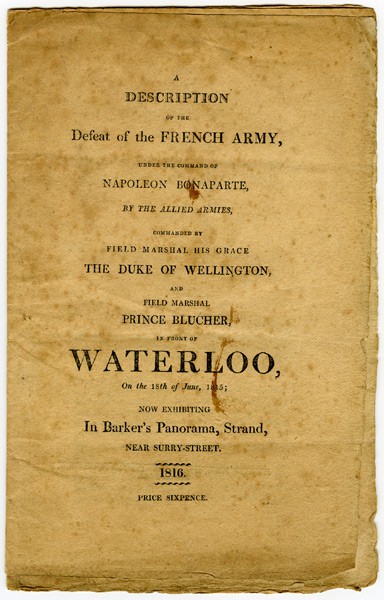
After making sketches on the spot in Belgium and interviewing some of the British participants in the battle, Henry Aston Barker, a Scottish panorama painter (1774-1856), opened his own panorama of the Battle of Waterloo on 30 January 1816 at the rotunda of Barker’s Panorama, on the Strand, which was run by his older brother Thomas. With their accompanying booklet, the visitor entering the panorama (for a shilling) could admire the battle at the moment of its triumphant conclusion, that is to say the general attack by the allied forces around eight o’clock in the evening. The Barker brothers were to earn £10,000 thanks to this vision of the battle – it was by far the most profitable of all their panoramas. In 1817 the scene was then relocated to Barker’s other Rotunda or Panorama in Leicester Square [originally created by their father, the panorama painter Robert (1739-1806)] – before travelling throughout the British Isles (with a stop in Edinburgh) and also to Boston in the United States.
The panorama by Peter and his son William Marshall (also from Scotland), Marshall’s Grand Historical Peristrephic Panorama of the Ever-memorable Battles of Ligny, Les Quatre Bras and Waterloo, which was created with the advice of Wellington’s close associates, Lord James Fitzroy Somerset (Wellington’s Military Secretary) and Colonel Francis Ponsonby, was also a great success. After a premiere in London in 1816, it toured to Bristol, Bath, Exeter, and Plymouth, Manchester, Dublin, before it too crossed the Atlantic. The accompanying booklet was reissued at least 14 times. Their show was more sumptuous than that of the Barkers, since the panels were mounted on rollers (hence the description “peristrephic”) and scrolled round, the whole thing being accompanied by a military brass band. In view of the technology required, this show cost twice as much as the Barkers’ static London show. Since 22,600 and 22,000 people saw the panorama in Bristol and Bath respectively, we can easily calculate that the show was a veritable goldmine for the Marshalls père et fils.[20]
In addition to the panoramas, “sightseers” in London could also admire live shows, such as the re-enactment of the battle in the Vauxhall Gardens, London’s world-famous pleasure park. For this, an open-air space had been equipped to accommodate 1,200 spectators on 40-metre-high terraces. The “show”, which recreated the battle, was premièred in 1827; it lasted two hours and included hundreds of extras, pyrotechnic effects and smoke.[21]
The “Waterloo museums”
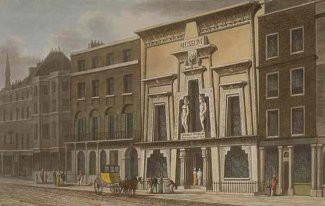
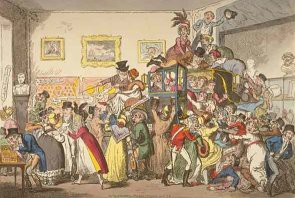
The exhibitions of “Waterloo” objects in London in the aftermath of the battle attracted “swarms of English [sic] bees”, as Cruikshank titled them at the top of his engraving satirising the mass of humanity swarming in, above, below, and around Napoleon’s “dormeuse” (carriage). This Imperial Carriage (as Cruikshank calls it) was exhibited in 1816 at the London Museum, also known as the Egyptian Hall, in Piccadilly Street. Up to then, the space had been a museum of natural history curiosities, but the Bullock room (named after the goldsmith) was converted into a museum of contemporary history immediately after the battle, with the addition of portraits of Napoleon by David and Lefèvre; it made a great profit (the entrance fee was one shilling). The audience ratings shot up with the addition of the captured carriage. This carriage, captured by Major von Koller, was given by the Prussian government to the Prince Regent, who (being short of funds) sold it to the entrepreneur William Bullock. By exhibiting it, Bullock made an amazing profit of £35,000. Then the carriage “travelled” to the provinces. Blackwood’s Magazine noted that in Edinburgh on 10 February 1817 “the exhibition of Buonaparte’s military car has attracted more interest than anything else in years.” Bullock, a real showman, had the carriage brought into town driven by Napoleon’s own coachman (Hornn, one-armed on account of his injuries) and four horses (also taken with the carriage). After many journeys, the famous carriage returned to London to take its place in Madame Tussaud’s collections.[22] There, in 1843, it was housed in what was called Napoleon’s “sanctuary or golden room”. Indeed, there is nothing surprising about there being a sanctuary to the Emperor in the land of “his most faithful enemies”, since the sanctuary’s booklet notes that “it goes without saying that everything concerning the late Emperor Napoleon is part of British history.“[23] But Bullock was not the only one who wanted to make a quick buck. A gigantic portrait of Napoleon by David (15 foot by 6 foot) was also exhibited at the “Waterloo Museum” in London.[24] This museum, established by a certain Mr. Palmer after the battle in 1815, not far from the Egyptian Hall, at No. 97 Pall Mall, was proud to exhibit four captured ‘eagles’ (Percy had only brought back two!), weapons, armour and paintings. The museum was staffed by veterans or war-wounded from the battle. Towards the end of 1815, these collections were expanded with a mural painting, breastplates, helmets, swords, rifles and bayonets (displayed in the so-called “Cuirassiers’ room”), all of them retrieved on the battlefield. Visitors could admire models of Murat and Marie-Louise, as well as, in the second room, the stove from Napoleon’s office in the Palace of Saint-Cloud. The third room exhibited Napoleon’s state saddle, and the fourth (quite incredibly, it must be said), Napoleon’s and Josephine’s coronation robes.[25] Still in the same part of London were the “Waterloo Exhibition” (at No. 1 Saint James’s[26]) – which showed superb dresses from the Empress’s apartment as well as objects recovered from the Belgian field – and also the “Waterloo Rooms” (94 Pall Mall) which was described as a fashionable lounge and which still in 1824 exhibited Marengo, Napoleon’s horse (still alive), with its battle scars and a bullet in his tail.[27]
And Napoleon in all this…
Thirty-five years after the battle, the French-language paper the Revue d’Empire[28] tried to argue (without irony) that the British public had accepted the obvious fact that Napoleon was a better general than Wellington and that Napoleon was in fact a genius. According to the publication “there is hardly an English cottage in which one does not see some image, some bust of Napoleon”.[29] This was doubtless a little excessive, but the article that published these surprising sentences was a report of another exhibition, this time Napoleonic, again at the Egyptian Hall, namely the collection of the British Napoleonophile, John Sainsbury, who had ruined himself financially by accumulating a mass of historical mementoes of Napoleon I. And what was at first set up as a museum soon became an exhibition organised to sell his fabulous collection. Considering the number of visitors who rushed to admire Sainsbury’s “treasures”, it could well be argued that even if the British public did not actually admire Napoleon, it was at least fascinated by him and somehow felt compassion for the fall of the great man. Of course, Sainsbury knew the other prominent British Napoleonist at that time, Barry O’Meara, the doctor who had treated the Emperor on the island of St Helena between 1815 and 1818. O’Meara had established himself as THE English-speaking collaborator of choice for the Imperial family during the 1820s. In 1819, just after being expelled from St Helena, O’Meara had been responsible for the publication in English of Napoleon’s own opinion on the battle he had lost, the famous ninth volume of Napoleon’s memoirs.[30] Three years later, this Anglo-Irish doctor published the bestseller of the day – Napoleon in exile or a voice from St Helena. The day the book came out (the first edition was published in 1822 by Simpkin Marshall and Co and was on sale in their offices at Stationer’s Hall on Ludgate Hill in London),[31] Napoleon in Exile caused a riot in the little courtyard in front of the building. A crowd had gathered in front of the building and the police had to intervene to contain it.[32] The book was a tremendous success, requiring three reprints in five years.[33] One can imagine that the member of Parliament Thomas Creevey was speaking for the general public when he said, “I wonder if you will be as interested in O’Meara and Buonaparte as I was and still am. I can think of nothing else…”[34] Although O’Meara published his book to defend himself against the slanderous statements of Hudson Lowe, the former governor of Napoleon’s island of detention, his sketch of Napoleon was very positive. And the Irish author O’Meara was not the only one to find financial benefit from publishing books on Napoleon. Sir Walter Scott saved his Abbotsford Castle and restored his finances to health with his “relatively neutral” work on Napoleon I.[35] Indeed, both O’Meara and Scott were working in a long tradition of biographies of Napoleon that began in 1797 with the first biographical work on Napoleon, and which was later translated into French. Certainly there was no shortage of attacks on the Corsican ogre, of which Goldsmith’s Secret History of the Cabinet of Bonaparte was a blatant example.[36] Nevertheless, half a dozen unbiased biographies appeared in English between 1800-1815, in addition to the attacks (the written equivalent of the cartoons of Gillray and Rowlandson). But even the conservative public had to accept that Napoleon had to be taken seriously. In his introduction to his translation of Machiavelli’s The Prince, John Scott Byerley (1810) pointed out that since Napoleon was just as cunning as Machiavelli’s Prince, this Florentine text needed to be studied in order to get ahead of him. In his six volumes also published during the years 1808-1815, Van-Ess sketched a Napoleon that was free of any ridicule[37]. So, once Napoleon had been defeated, the terrain was freer for writers to treat the Emperor of the French in a more nuanced if not actually positive manner.
The crisis and the discontent of the people
Despite the fact that the (almost unexpected) victory at Waterloo was a ‘ray of sunshine’, public life in Great Britain was subject to much contention during this post-war period. Gradually the concept of “public opinion” had begun to appear, and it began to take on political significance. Large gatherings (such as the one for peace in 1814) now became a fixed element of political life on the island. From then on, governments felt obliged to recognise (at least symbolically) what the ‘people’ thought. At the same time, the end of the war, and thus the demobilization of tens of thousands of men, brought a surplus of workers onto the market, with resulting overproduction, due to the end of the hostilities. In this climate of diverging public opinion and unemployment, mass protests against the poverty and suffering resulting from the post-war economic crisis were violently suppressed.[38] At Spa Fields (London) in November and December 1816, a liberal “meeting” ended in violence. The March of the Blanketeers (textile workers) from Manchester in March 1817 was severely put down when the Royal Cavalry attacked the demonstrators, seriously wounding many with their sabres. In June of the same year it was the same story, with the uprising of weavers and quarrymen and the workers of the Pentrich and Derbyshire steel industry, whose three leaders were hanged in public. The government reacted brutally by suspending the Habeas corpus law, thereby ensuring the legality of detaining prisoners; it also introduced the infamous Gagging acts, including the 1817 law, which made it illegal to hold meetings of more than 50 people, calling such meetings “seditious”.
In August 1819 this culminated with the charge made by the mounted militia on a demonstration at Peter’s Fields in Manchester. With more than 400 wounded and 11 to 15 dead, history has remembered this butchery by naming it Peterloo, after the battle of Waterloo, to emphasise the bloody nature of the incident. This is probably the most telling example of what the name Waterloo “said” to the British in the beginning of the 1820s – a massacre.
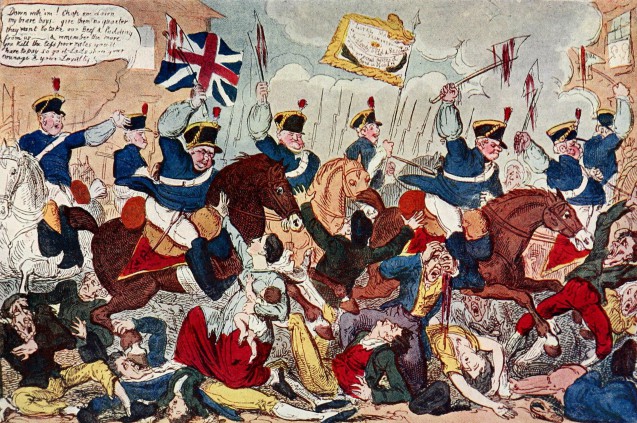
Conclusion
To conclude, then, although at first sight the battle was celebrated resoundingly, as well as with a national day of commemoration, there was also great sadness for the dead and wounded, and collections for orphans and widows. Ambivalent feelings about the battle also continued in public life with governments that could never decide on the construction of truly national memorials – it was thirty years before a medal was awarded to the veterans. The disappointment of the most liberal was manifest alongside the Conservatives’ triumphalism. On the other hand, as far as entertainment with the Waterloo theme was concerned, everybody could be sure of having their fill, and even more. Napoleon’s carriage, the itinerant panoramas, the London museums and their exhibitions of objects and even animals met with great public enthusiasm. With publications such as Barry O’Meara’s two best-selling volumes and Walter Scott’s books, a feeling of pity and even respect was gradually spreading among an English-speaking audience. In the 1840s, on both sides of the English Channel, the Battle of Waterloo had ceased to be a stumbling block. One could be passionate about the Emperor without being considered unpatriotic. When people thought of the famous battle, it was with the idea of the fall of a modern Prometheus and a bloodbath of monstrous proportions.
This is a transcript of a paper given by Peter Hicks, in June 2015 at the symposium “The Battle of Waterloo: symbole de victoire, de défaite, et lieu de mémoire”, organised by the Fondation Napoléon and Bataille de Waterloo 1815 absl and the Editions de la Belle Alliance, on the occasion of the 200th anniversary of the Battle of Waterloo. (English translation by Paul Willenbrock with Peter Hicks)
Footnotes
[*] Adams, John Quincy, Memoirs of John Quincy Adams, comprising portions of his diary from 1795 to 1848, Philadelphia, J.B. Lippincott & Co., 1874-77, vol. 3, “23d. [June 1815].
[1] See Reginald Colby, The Waterloo despatch; the story of the Duke of Wellington’s official despatch on the Battle of Waterloo and its journey to London. London: H. M. Stationery Office, 1965, Diaries of a Lady of Quality [Frances William Wynn] from 1797 to 1844, Edited, with notes, by A. Haywood, London: Longman, Green, Longman, Roberts, & Green, 1864, 2nd edition, p. 164-69.
2 See Edward Fraser, The War Drama of the Eagles, New York: E.P. Dutton and Company, 1912, p. 424-9.
3 “Address for a National Monument, and Monuments to Officers who fell in the Battle of Waterloo”, Hansard, House of Commons Debate, 29 June 1815 vol 31 cc1048-57, on line (consulted in February 2015) https://api.parliament.uk/historic-hansard/commons/1815/jun/29/address-for-a-national-monument-and
4 The newspaper The Times (Number 9554) (p. 2) also published the despatch (explicitly taken from the London Gazette Extraordinary) as “stop press” at 11 am, that is to say after part of the newspaper had been set. The Morning Post and The Morning Chronicle (p. 3) did not publish the despatch as The Times had done, but rather produced a short account – the 2nd edition of the Post (on the same day) published (with the Times) one of the first lists of the wounded and the dead.
[5] See John Timb, London and Westminster: city and suburb, vol. II, London: Richard Bentley, 1868, p. 190-91.
[6] See Holger Hoock, Empires of the Imagination, Politics, War, and the Arts in the British World, 1750-1850, London: Profile Books, 2010, p. 361-72. For Playfair’s National Monument see http://www.edinburgharchitecture.co.uk/national-monument (consulted in February 2015).
[7] W. S. W. Vaux, On English and Foreign Waterloo Medals, The Numismatic Chronicle, N. S. IX (1869), pp. 108-117.
[8] See letter from the English Member of Parliament for Shrewsbery, Henry Grey Bennet, to Thomas Creevey in Brussels, dated July 1815, published in Herbert Maxwell (ed.), The Creevey papers: a selection from the correspondence & diaries of Thomas Creevey, M.P., born 1768 – died 1838, London: John Murray, vol. 1, 1904, p. 240-41.
[9] Lord Byron, The Age of Bronze; or, Carmen Seculare et Annus haud Mirabilis, London: Printed for John Hunt, 1823.
[10] Lord Byron, Childe Harold’s Pilgrimage, Canto the Third, London: John Murray, 1816, in particular the stanzas 18 and 19 (p. 12).
[11] See E. Tangye Lean, The Napoleonists. A study in Political Disaffection 1760-1960, Oxford: OUP, 1970, p. 107-113.
[12] Op. cit., p. 262-3, and also Simon Bainbridge, Napoleon and English Romanticism, Cambridge: CUP, 1995, p. 188-90.
[13] William Cobbett, Cobbett’s Weekly Political Register (16 September, 1815), “Political Delusion”.
[14] Quoted in Anthony Dawson, “Marking Waterloo”, http://www.napoleon-series.org/research/miscellaneous/c_MarkingWaterloo.html (consulted in February 2015).
[15] See for example Anon, A description of the Defeat of the French Army under the Command of Napoleon Bonaparte, London: 1816; “An eye-witness”, The Journal of the three days of the Battle of Waterloo, London: Proprietors, Military Chronicle and Military Classics Office, 1816; “British officer on the staff”, An Account of the Battle of Waterloo, London: James Ridgeway, 1815; “A near observer”, The Battle of Waterloo, London: John Booth, Duke Street, Portland Place; T. Egerton, Military Library, Whitehall; J. Fairbairn, Edinburgh, 1816.
[16] Willem Lodewyk Van-Ess, Life of Napoleon Buonaparte, vol. VIII, Part II, London: William Day, 1823, p. 912-22.
[17] William Wordsworth, “Thanksgiving Ode, January 18, 1816, with other short pieces chiefly referring to recent public events”, London: Longman, Hurst, Rees, Orme, and Brown, 1816; Robert Southey, “The Poet’s Pilgrimage to Waterloo”, London: Longman, Hurst, Rees, Orme, and Brown, 1816; Sir Walter Scott, “The Field of Waterloo; A Poem”, Edinburgh: Archibald Constable & Co; and Longman, Hurst, Rees, Orme, and Brown, and John Murray, London, 1815.
[18] W. Mudford (1782-1848), An Historical Account of the Campaign in the Netherlands, in 1815, Under His Grace the Duke of Wellington … Comprising the Battles of Ligny, Quartre Bras, and Waterloo, London: Henry Colburn, 1817.
[19] Letter quoted in Samuel Davey, “The Study of Familiar Letters as an Aid to History and Biography”, in Transactions of the Royal Society of Literature of the United Kingdom, 2nd Series, XXII (1900), part 2, p. 20.
[20] See John Plunkett, ‘Moving Panoramas c. 1800 to 1840: The Spaces of Nineteenth-Century Picture-Going’, Interdisciplinary Studies in the Long Nineteenth Century, No 17 (2013), online here http://www.19.bbk.ac.uk/rt/printerFriendly/674/933 consulted in March 2015.
[21] For a description of the show see Tour in England, Ireland, and France in The Years 1826, 1827, 1828, AND 1829. With Remarks on the Manner and Customs of the Inhabitants and Anecdotes of Distinguished Public Characters, in a series of letters, by a German Prince, Philadelphia: Carey, Lea and Blanchard, 1833, pp. 156-158 http://www.vauxhallgardens.com/vauxhall_gardens_princestour_page.html (consulted in February 2015). See also Richard D. Altick, The Shows of London, Cambridge (MA): Harvard University Press, 1978, p. 320.
[22] See The Military Carriage of Napoleon Buonaparte […] Copy of Mr Bullock’s original Catalogue, London: printed for the owners, Madame Tussaud and son, 1843, p. v.
[23] Id., p. v-vi and 24.
[24] See David Hughson (pseud. of Edward Pugh), Walks through London, London: Sherwood, Neely and Johns, 1817, p. 239-30, and R. D. Altick, op. cit., p. 238-40.
[25] See Joseph Nightingale, The Beauties of England and Wales or Original Delineations topographical historical and descriptive of each County, Vol. X, Part IV, London: J. Harris et al., 1815, p. 256-9.
[26] For a contemporary description of the collection, see Lt.-General Scott, Battle of Waterloo or Correct Narrative of the late Sanguinary Conflict on the Plains of Waterloo, London: E. Cox and Son, 1815, p. 172-3 note *.
[27] R. D. Altick, op cit., p. 239.
[28] For this national revue, which was sponsored by Louis-Philippe, see Frédéric Bluche, Le Bonapartisme: aux origines de la droite autoritaire (1800-1850), Paris: Nouvelles Editions Latines, 1980, p. 253-8.
[29] Revue de l’Empire, founded in 1842 by M. Ch.-Ed. Temblaire, Second year [1843?], “Le musée Napoléon à Londres”, p. 50.
[30] Historical Memoirs of Napoleon, Book IX, 1815, translated from the original ms by B.E. O’Meara, with an appendix that the pretended manuscript from St Helena was not written by Napoleon, London; Sir Richard Philipps and Co., 1820.
[31] The contract was published in was published in Joseph Shaylor, The Fascination of Books: with other papers on Books & Bookselling, London, Simpkin Marshall Hamilton Kent and Co Ltd, 1912, pp. 208-214, giving the date as 5 July 1822.
[32] See Shaylor, op. cit., p. 207.
[33] On 17 March 1824, 10,000 copies of the book had been printed, see Shaylor, op. cit., p.214
[34] Thomas Creevey M.P., 21 July 1822, in The Creevey Papers: A selection from the correspondence & diaries of Thomas Creevey, M.P., born 1768 – died 1838; edited by Sir Herbert Maxwell, London: John Murray, 1904..
35 Walter Scott, The Life of Napoleon Buonaparte, Emperor of the French. With a Preliminary View of the French Revolution, Edinburgh: Cadell; London: Longman’s, 1827, which also appeared in French as Vie de Napoléon Buonaparté : précédée d’un tableau préliminaire de la Révolution française, Paris : Treutttel & Würtz, 1827; see Chantal Lheureux-Prévot, Pages napoléoniennes, http://www.napoleon.org/fr/salle_lecture/articles/files/Pagesnapo_walterscott.asp, consulted in February 2015.
[36] Lewis Goldsmith, Secret History of the Cabinet of Bonaparte, London: J. M. Richardson and J. Hatchard, 1810, which also appeared in French as Cabinet de Napoléon Buonaparte et de La Cour de St. Cloud, London: T. Harper Le Jeune, 1810.
[37] For details of all these publications see Peter Hicks, “Late 18th-century and very early 19th-century British writings on Napoleon: myth and history”, Napoleonica. La Revue 3/2010 (N°9), p. 105-117.
[38] See Jenny Uglow, In These Times: Living in Britain through Napoleon’s Wars, 1793-1815, London: Faber & Faber, p. 638 ff.


